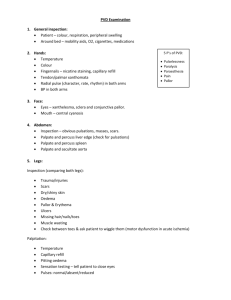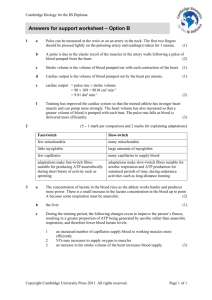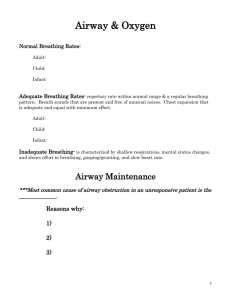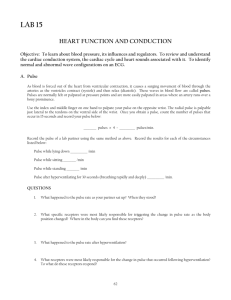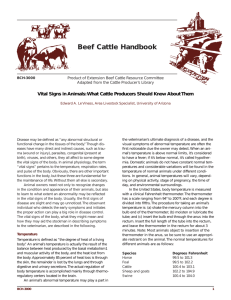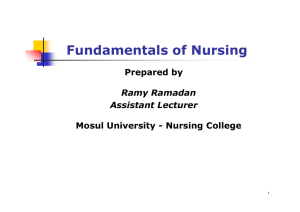Vital Signs Assessment: Pulse, Respiration, and More
advertisement
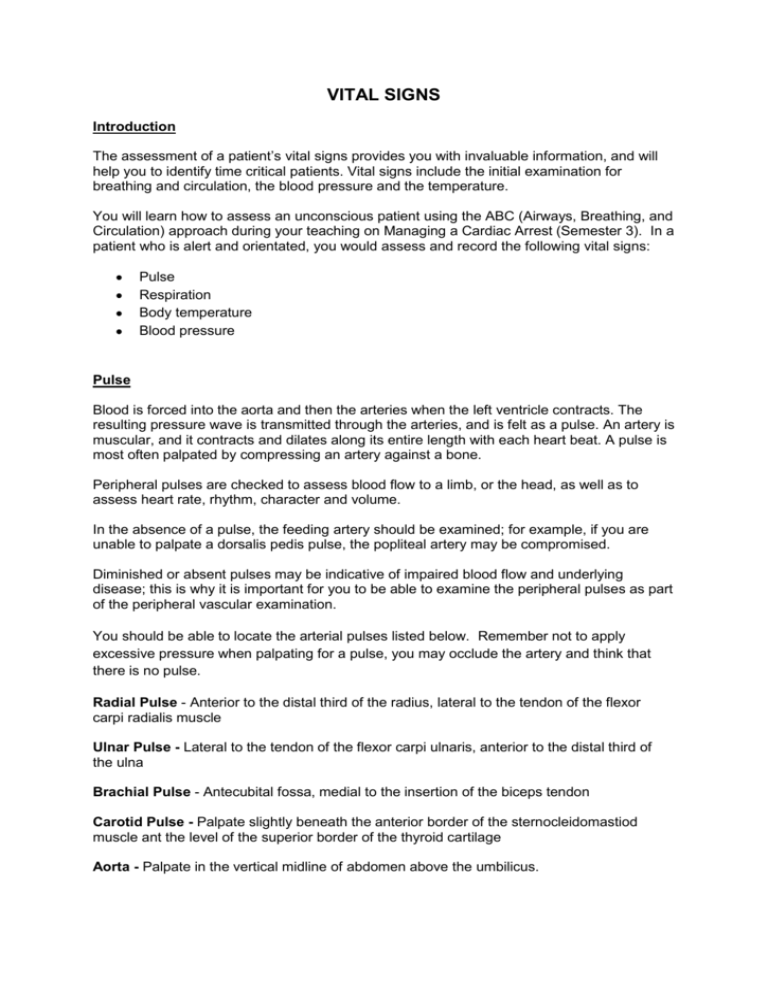
VITAL SIGNS Introduction The assessment of a patient’s vital signs provides you with invaluable information, and will help you to identify time critical patients. Vital signs include the initial examination for breathing and circulation, the blood pressure and the temperature. You will learn how to assess an unconscious patient using the ABC (Airways, Breathing, and Circulation) approach during your teaching on Managing a Cardiac Arrest (Semester 3). In a patient who is alert and orientated, you would assess and record the following vital signs: Pulse Respiration Body temperature Blood pressure Pulse Blood is forced into the aorta and then the arteries when the left ventricle contracts. The resulting pressure wave is transmitted through the arteries, and is felt as a pulse. An artery is muscular, and it contracts and dilates along its entire length with each heart beat. A pulse is most often palpated by compressing an artery against a bone. Peripheral pulses are checked to assess blood flow to a limb, or the head, as well as to assess heart rate, rhythm, character and volume. In the absence of a pulse, the feeding artery should be examined; for example, if you are unable to palpate a dorsalis pedis pulse, the popliteal artery may be compromised. Diminished or absent pulses may be indicative of impaired blood flow and underlying disease; this is why it is important for you to be able to examine the peripheral pulses as part of the peripheral vascular examination. You should be able to locate the arterial pulses listed below. Remember not to apply excessive pressure when palpating for a pulse, you may occlude the artery and think that there is no pulse. Radial Pulse - Anterior to the distal third of the radius, lateral to the tendon of the flexor carpi radialis muscle Ulnar Pulse - Lateral to the tendon of the flexor carpi ulnaris, anterior to the distal third of the ulna Brachial Pulse - Antecubital fossa, medial to the insertion of the biceps tendon Carotid Pulse - Palpate slightly beneath the anterior border of the sternocleidomastiod muscle ant the level of the superior border of the thyroid cartilage Aorta - Palpate in the vertical midline of abdomen above the umbilicus. Femoral Pulse - Lay the patient flat. Palpate the femoral artery halfway between the pubic tubercle and the anterior superior iliac spine by using your index and middle fingers together, pointing upwards and slightly medially Popliteal Pulse - Using both hands, flex the knee slightly. Place the thumbs on the front of the knee and palpate the popliteal fossa with the fingers. Practice Tip! Remember not to apply excessive pressure when palpating for a pulse, you may occlude the artery and think that there is no pulse. Posterior Tibialis - Palpate with the index and middle fingers just posterior and inferior to the medial malleolus Dorsalis Pedis - Between the bases of the 1st and 2nd metatarsals, 1/3rd of the way down the dorsum of the foot, lateral to the extensor hallucis tendon Respiration When assessing respiration you need to note both the respiratory rate and the characteristics of respiration. Normal respiration results in even movement of the ribcage and should be effortless, automatic and regular, producing no noise or discomfort. An irregular breathing rhythm may indicate the presence of injury or illness. Abnormal breathing may require effort or be accompanied by pain or noises such as wheezing, rattling or stridor. Many of these changes are characteristic of particular illnesses or problems. The respiratory rate should be counted for a full minute. One respiration consists of one inhalation and one exhalation. You should try to assess the respiratory rate without the patient being aware of what you are doing or this can result in alteration of the rate and depth of breathing. Body Temperature Core body temperature is maintained at about 37 C in an adult but can increase or decrease with illness. It is important to be able to gain an accurate body temperature, as changes can be important diagnostic indicators. For example, a collapse may be due to heat syncope, or an elderly acutely confused person may be hypothermic. The main sites for the measurement of body temperature are: Oral – reading taken in the mouth, under the tongue Tympanic – reading taken from the tympanic membrane Rectal – reading taken from inside the rectum Axillary – reading taken under the armpit, or between two folds of skin Consideration must be given to the normal changes in body temperature that are observed when comparing gender, time of day and age, as well as the temperature site. You must ensure that when taking a temperature, there are no environmental factors which will lead to an erroneous reading. Taking an oral temperature from a person who has just swallowed hot coffee will give you a falsely high reading, as will taking a tympanic temperature in the ear that the person was sleeping on. Blood Pressure Measurement of blood pressure is an important skill, and done correctly will provide you with valuable diagnostic information. A person’s blood pressure is not static and undergoes natural variation from one heartbeat to another and throughout the day. Blood pressure also changes in response to stress, nutritional factors, drugs, illness, exercise, and changes in posture. Hypertension refers to arterial pressure being abnormally high, as opposed to hypotension when it is abnormally low. Measurement of blood pressure includes the systolic pressure and the diastolic pressures. It is written as systolic/diastolic, for example 112/76 mmHg (millimetres Mercury). Blood pressure measurement is a skill you will need to practise, as a careful, precise approach will ensure the reading is correct. When taking a blood pressure, it is important that you consider environmental and positional issues which may cause an erroneous reading. The environment and procedure should be as stress free as possible, as blood pressure can vary depending on emotional states, stress, position of the patient and the environment. The sounds listened for whilst taking a blood pressure are called Korotkoff Sounds.

